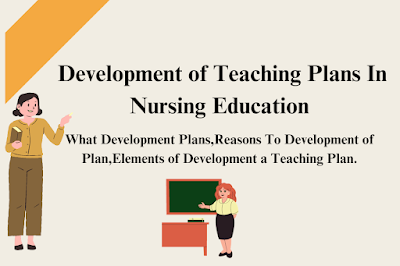The Behavioral Objectives and Teaching Plans In Nursing Education. A behavioral objective is a measurable learning outcome that provides direction for the learner and forms the basis for student assessment. Objectives can be different in many ways. They can be general or specific, concrete or abstract, cognitive, affective, or psychomotor.
The Behavioral Objectives and Teaching Plans In Nursing Education
In nursing education, behavioral objectives are specific, measurable statements that describe what a student should be able to do after a unit of instruction. They guide the teaching process and serve as the basis for assessment. Lesson plans, on the other hand, describe in detail the activities and strategies that will help students achieve these objectives. They are crucial for effective and efficient learning in nursing education.
Key elements of behavioral objectives:
Performance: Describes the specific action the student will perform.
Condition: Describes the circumstances under which the behavior is expected.
Criteria: Specifies the degree of accuracy or timeframe within which the behavior must be performed.
What are Development Plans in Nursing Education?
Development plans in nursing education refer to structured blueprints that guide the process of teaching, focusing on helping the learner meet specific objectives. After setting mutually agreed goals and objectives, a teaching plan is created to serve as a comprehensive guide, outlining how the learner will achieve the desired learning outcomes. A teaching plan includes the purpose of the teaching session, the content to be taught, instructional methods, timing, resources, and methods of evaluation.
Reasons for Developing a Teaching Plan
Teaching plans are essential for the following reasons:
- Ensure a Logical Approach: They help educators systematically connect each step of the teaching process.
- Clarify Teaching and Learning Processes: Clearly describe what is being taught, how it will be taught, and the time allocated for each objective, ensuring that all team members are aligned.
- Legal Documentation: Teaching plans provide legal evidence that an individual plan is in place and being implemented. They are often required for accreditation and policy adherence, ensuring a standardized approach to teaching across healthcare settings.
Elements of Developing a Teaching Plan
A comprehensive teaching plan should include the following eight components:
- Purpose: This explains the reason behind the educational session and outlines the learning goal.
- Goal: A broad statement describing what the learner should achieve by the end of the teaching session.
- Objectives: Specific, measurable behaviors that the learner is expected to demonstrate.
- Content Outline: A detailed list of the topics or skills to be covered in the teaching session.
- Instructional Methods: The strategies used to teach the content (e.g., lectures, demonstrations, group discussions).
- Time Allocation: The time required for teaching each objective, ensuring that sessions are manageable and focused.
- Instructional Resources: Materials, tools, and equipment needed to facilitate the teaching session (e.g., models, handouts, videos).
- Evaluation Methods: The techniques used to assess whether the learner has met the objectives (e.g., return demonstration, quizzes, written tests).
Internal Consistency in a Teaching Plan
A teaching plan must be internally consistent, meaning that each component should be aligned with the others. For example, if an objective focuses on a psychomotor skill (e.g., changing a wound dressing), all aspects of the teaching plan—from the goal and content to the instructional method and evaluation—should reflect the psychomotor domain. This ensures the teaching plan is cohesive and focused on achieving the desired outcomes.
Example of a Teaching Plan
Here’s an example illustrating internal consistency in a teaching plan for post-circumcision care:
- Purpose: To provide mothers with the knowledge and skills needed for post-circumcision care.
- Goal: The mother will independently manage post-circumcision care for her newborn.
- Objective: Following a 20-minute teaching session, the mother will be able to demonstrate proper post-circumcision care with each diaper change.
In this example, the purpose, goal, and objective align with teaching a psychomotor skill, ensuring that the instructional methods (demonstration and return demonstration), content, and evaluation methods support the objective.
Additional Considerations for Developing a Teaching Plan
When developing a teaching plan, consider the following factors:
- Domain of Learning: Determine which domain(s)—cognitive, affective, or psychomotor—are most relevant to the learning goals.
- Learner’s Readiness: Assess the learner’s needs, readiness, and learning style to ensure that the content and methods are appropriate.
- Practical Considerations: Consider the feasibility of the methods. For example, self-instruction using online resources may not be suitable for learners without internet access or technical skills.
Evaluation of Teaching Plans
Evaluation methods must match the learning domain associated with each objective. For instance, a patient learning how to use a medication inhaler (psychomotor domain) would be evaluated through return demonstrations, whereas a patient learning about heart attack symptoms (cognitive domain) could be evaluated using a post-test or verbal questioning.
Conclusion
Developing teaching plans in nursing education is a critical skill that ensures effective and organized teaching. Each element of the plan—purpose, goal, objectives, content, methods, time, resources, and evaluation—must be interrelated and aligned to meet the learning objectives. Additionally, plans must be realistic and adaptable to the learner’s needs and the healthcare setting, ensuring that education is both practical and efficient.
Read More:
https://nurseseducator.com/didactic-and-dialectic-teaching-rationale-for-team-based-learning/
https://nurseseducator.com/high-fidelity-simulation-use-in-nursing-education/
First NCLEX Exam Center In Pakistan From Lahore (Mall of Lahore) to the Global Nursing
Categories of Journals: W, X, Y and Z Category Journal In Nursing Education
AI in Healthcare Content Creation: A Double-Edged Sword and Scary
Social Links:
https://www.facebook.com/nurseseducator/
https://www.instagram.com/nurseseducator/
